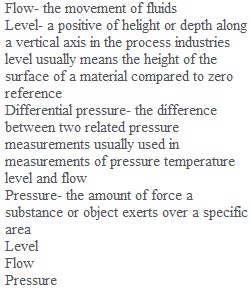


Q PROCESS INSTRUMENTATION CH. 2 TEST l. Flow ll. Level lll. Differential pressure lV. Temperature V. Pressure 1.__a Force applied to a specific area 2.__b. The movement of fluids 3.__c. Height of the surface of a material compared to 4.__a zero reference point 5.__d. The measure of thermal energy of a substance 6__e. Difference between pressure measurements taken from two separate points A. Pressure gauge B. Atmosphere C. Differential pressure cell (D/P cell) D. Pressure gauge E. Atmospheric pressure F. Differential pressure (D/P) G. Bar H. Density I. Capacitance transducer J. Force K. Molecular speed L. Inches of mercury (in. Hg) M. Local indicators N. Mass O. Molecular speed P. Vacuum Q. U-tube manometer R. Specific Gravity S. PSIG T. Strain gauge transducer U. PSIA 7.__-the most common local instrument type for measuring pressure; the three primary types of pressure gauge measuring scales are absolute, gauge, and vacuum. 8.__-the pressure at any point in the atmosphere due solely to the weight of the atmospheric gases as above the point concerned: 14.7 PSIA, which equals atmosphere is the pressure at sea level. 9.__-an instrument that measures the difference between two related pressure points and produces a corresponding output signal that is proportional to the process being measured. 10.__-the most common local instrument type for measuring pressure; the three primary types of pressure gauge measuring scales are absolute, gauge, and vacuum. 11.__-the pressure at the surface of the earth (14.7 PSIA at sea). 12.__the difference between two related pressure measurements; wally wed in measurements of pressure, temperature, level, and flow. 13.__-measurement of pressure equal to 0.987 atmospheres. 14.__-mass per unit volume. 15.__-an electrical device that contains a measurement diaphragm and capacitor plates; it converts an applied pressure to an electronic signal measurement that is proportional to the process being measured. 16.__-the difference between two related pressure measurements; wally wed in measurements of pressure, temperature, level, and 17.__-energy that causes a change in the motion of an object, involving strength or direction of push or pull. 18.__--the rate of motion of molecules in a substance; it may change as a result of factors such as heat or collision with other molecules (e.g., the walls of a vessel). 19.__-most common measurement scale for a manometer; measures in pounds per square inch; 1 inch Hg = 13.0687 inches F Inches of water in. H0-a very small measurement of pressure eca el to 0056 pounds per square inch at 4 degrees Celsius (39.2 degrees Fahrenheit). 20.__-instruments placed on equipment in the field only be read in the field may be used for comparison with transmitted instrument readings or used on noncritical processes to indicate process values. 21.__-the amount of matter in a body or object measured by its resistance to a change in motion. 22.__-a condition in which the pressure measured is less than atmospheric pressure, usually measured in inches of mercury (in. Hg). 23.__- pounds per square inch absolute; zero on the absolute scale would represent the absence of any pressure. 24.__-a gravity balanced pressure measuring device with two fluid chamber tube gauges connected by a U-shaped tube so fluid (a liquid or mercury) flows freely between the chambers. 25.__pounds per square inch gauge pressure measurement that references 14.7PISA as its zero point. 26.__-the ratio of the density of a liquid or solid to the density of pure water or the density of a gas to the density of air at standard temperature and pressure (STP). 27.__ a pressure sensing and measuring device consisting of a group of wires that stretch when pressure is applied, creating resistance, thereby changing the process pressure into an electronic signal. 28. Pressure is described as_____per unit area. a. flow b. pounds c. force d. inches 29. Pressure is increased when: a. the number of molecules per unit area is decreased. b. heavier molecules per unit area are introduced. c. molecules begin to move faster. d. the number of molecules are spread out over a larger unit area 30. Atmospheric pressure at sea level is PSIA. a. 0 b. 2 c. 14.7 d. 29.92
View Related Questions